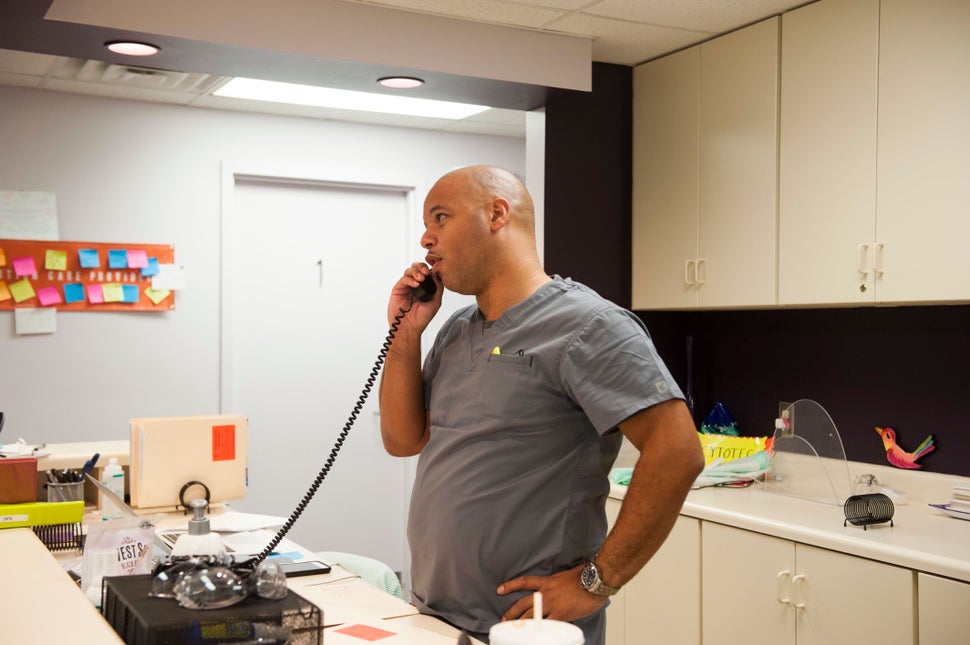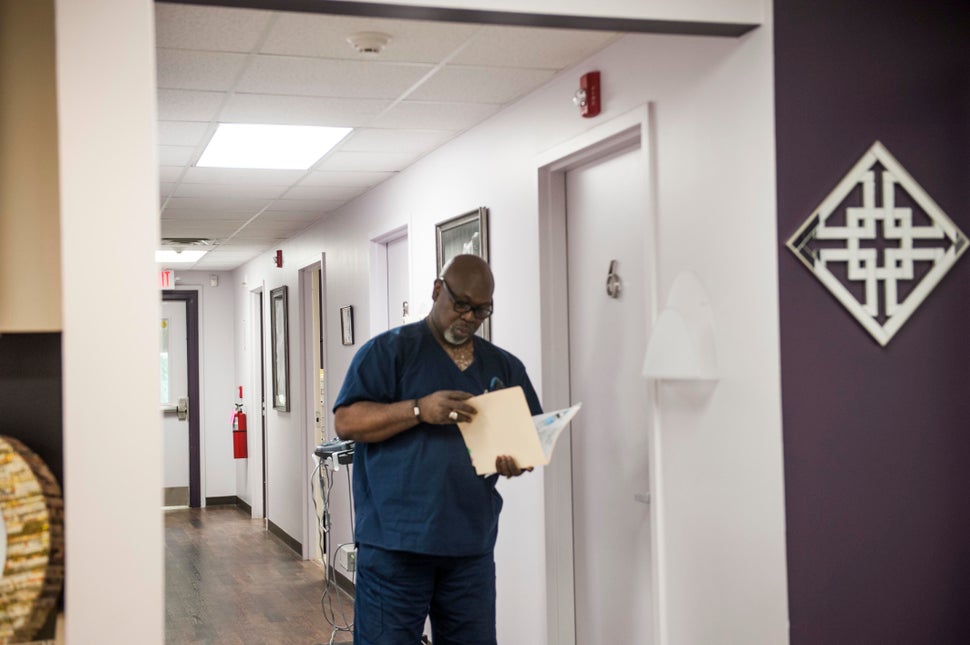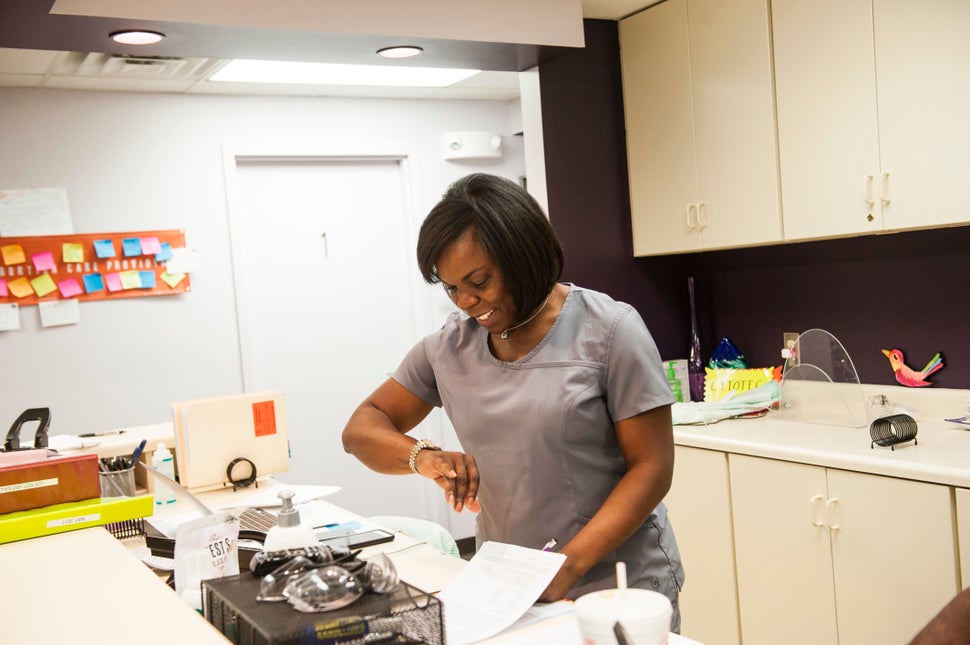
HUNTSVILLE, ALABAMA — Dr. Willie Parker, one of Alabama’s few remaining abortion providers, was driving to work when he got the call. The name “Dalton Johnson” flashed on the SUV’s dashboard screen, as Parker switched on his headset. He listened as Johnson, the owner of the abortion clinic where he was headed, explained the problem.
A patient at the Huntsville clinic who was 21 weeks pregnant needed an abortion, but she was also a regular user of opioids. This meant she wouldn’t be able to receive medication to help ease the pain of the procedure ― which, like any surgery, can be agonizing ― because her use of opioids could nullify the effects of many pain relievers.
After about 15 minutes of discussion, Parker told Johnson he couldn’t take the case. “I hate to turn anyone away,” he said after hanging up. “But if something goes wrong, no one is going to remember that I was trying to help this woman.”
Alabama, like the rest of the nation, has been hit hard by the opioid crisis, with overdose deaths at an all-time high and a generation of children making their way into foster care. But other victims of the crisis ― victims who are not uncommon ― are pregnant women seeking abortions, like the patient at the Alabama Women’s Center for Reproductive Alternatives in Huntsville.
Parker says these women tend to be poor, white and in their second trimester. It’s not that they wait until the last minute to seek an abortion, he added. It’s more a matter of not knowing they’re pregnant ― opioid users may ovulate less frequently and therefore have irregular cycles ― and not having enough money to pay for an abortion.
“Their lives may not be together enough to get in early to get the abortion,” he said. “When they show up and they’re 15 or 16 weeks, they say they didn’t know they were pregnant.” He added that most of the women he sees are African-American, but of the opioid-addicted women he treats, most of those patients are white.
Abortion providers say they are seeing an uptick in pregnant women who fit this profile. Johnson estimates about 10 percent of patients use opioids.
Gloria Gray, who runs the West Alabama Women’s Center in Tuscaloosa, has seen a similar uptick. “It’s very unfortunate, because there’s not much we can do to help them,” she said. “We could give them everything we have in the clinic and it wouldn’t faze them.” It’s not that there’s no medical way to relieve pain during these abortions; the clinics are restricted to certain methods of pain relief, and keeping a nurse anesthetist or anesthesiologist on staff would make the procedure too expensive for most patients.
Gray said her nurses are now having to discourage opioid-addicted patients from self-medicating in preparation for the procedure. “We just have to talk to them and explain it to them that they’re going to have to have a strong will and a strong mind,” she said, adding the nurses try to be upfront with the women, but “those are the ones that usually end up screaming.”

Alabama leads the nation in its ratio of opioid prescriptions per capita, at 1.2 prescriptions per person compared with the national average of 0.76. Its increase in opioid deaths between 2014 and 2015 was one of the five greatest in the nation, and the state attorney general says Alabama has “disproportionately suffered” from the opioid epidemic.
Alabama also has some of the nation’s most severe restrictions on abortion. To obtain an abortion at one of Alabama’s four remaining clinics, a woman must make two trips to the clinic, 48 hours apart. The first visit involves an ultrasound during which the provider must offer the patient the option to view the image. It also involves state-mandated “counseling” which, like the state-mandated brochures clinics are required to offer patients, is designed to discourage abortion. (One brochure refers to the fetus as “the unborn child.”)
Even patients who are obtaining the abortion pill, which induces a miscarriage that happens off the premises, are required to make two appointments.
The state’s legal cutoff for abortion is 22 weeks, making it a destination for women from states with more stringent cutoffs; at Johnson’s clinic and at the clinic in Tuscaloosa, where Parker also practices, patients come from Tennessee, Florida and Mississippi.

Although the patient Parker and Johnson were talking about was from Birmingham, she was 21 weeks and 1 day pregnant, which meant her procedure would have to be a dilation and evacuation, or D&E. Parker would have to use drugs to soften her cervix to conduct the abortion procedure in order to be able to insert his instruments into her uterus and remove the fetus.
Softening (or “ripening”) the cervix ― which opens it up to allow for the abortion procedure to take place ― causes cramping and can take all day. Usually Parker would begin the softening process the day before the procedure. But this patient had come in on the Friday before the long Independence Day weekend.
The clinic wouldn’t be open again until the following Wednesday, by which point she would be perilously close to the 22-week cutoff. After that, her options would be so limited as to be meaningless: It’s possible to get an abortion after 22 weeks in the United States, but only in a few states, none near Alabama. The procedure would cost between $8,000 and $10,000 — and that’s before airfare, accommodation and days of missed work.
To add to the patient’s concerns, Alabama has been aggressive about prosecuting women who use drugs while pregnant. Given the abortion restrictions in surrounding states, given the looming public holiday and given this woman’s desire not to become a mother, Parker and Johnson both knew they were her last best hope.
None of these clinical challenges would be insurmountable for Parker under normal circumstances, but the patient’s drug misuse made the procedure complicated and was the reason Parker initially believed he could not help her.

The patient, who allowed a reporter from HuffPost to observe the process, refused to specify which drugs she had been using, saying only that she took “pain meds for anxiety.” Parker was worried that even the maximum pain relief he was permitted to give her at the clinic wouldn’t make a dent in the pain of the surgery, making the procedure unbearable for her.
The patient, 25, was petite ― about 115 pounds ― and had never given birth before, meaning her cervix was much tighter than it would have been had she already had a child. Pain relief would be required, but her opioid habit could render it ineffective. Unlike most opioid-using patients that Parker sees, this woman was African-American; most opioid users who come to the clinic are white, as that’s the population that’s been hit hardest in the area.
Opioids relieve pain by bonding to the body’s mu receptors, blocking them and thus their ability to convey pain. “The body isn’t dumb,” says Dr. Nitin Sekhri, a pain management specialist at Westchester Medical Center. “Once you start to block a receptor, it just makes more. So your body ends up with more pain receptors, and the pain relief treatment stops working.”
Moderate pain becomes extreme pain as the body makes more and more receptors in response to more and more opioids. This is opioid-induced hyperalgesia, and it’s an enormous challenge for doctors who need to operate on people who are addicted to opioids.
Parker said he wasn’t willing to take the risk of operating on someone whose pain might not be adequately controlled. It’s a clinical decision, but he also considered the political implications.
If something were to go wrong, the negative attention that would be trained on him and on the clinic, he said, could hinder their ability to provide abortions for other women.
Johnson says his clinic has performed about 20,000 abortions since 2001, and about eight of those cases have required hospitalization due to complications. Still, this case was close to the edge of Parker’s clinical abilities, and if something went awry, “it’s just another botched abortion,” he said, and a ripe opportunity for anti-abortion activists and legislators to pounce in the name of women’s health. As Parker explains in his recent book, Life’s Work: A Moral Argument for Choice, bending the rules and skirting the edge of his clinical abilities simply aren’t worth the risk.
In the end, Johnson and Parker agreed on a solution: Dr. Yashica Robinson, the clinic’s chief abortion provider, would do the patient’s procedure. Robinson is the only doctor other than Parker in Alabama performing abortions after 14 weeks. Robinson would perform a cervix ripening procedure using a transcervical Foley balloon, which Parker had observed but could not yet perform himself. Robinson inserted a catheter into the patient’s uterus and inflated it such that it put pressure on the cervix, causing dilation.

Robinson waited until the very end of the day to perform the abortion, giving the patient’s cervix as long as possible to soften. The patient was lightly sedated and given non-opioid pain relief ― ibuprofen ― but the pain of the ripening process was considerable. At one point, she limped down the hall to the bathroom and begged for another pill as she’d vomited up the first one.
By the time Robinson put on her sterile shoe covers and a smock over her scrubs, the patient was drowsy, sedated and lying back on the chair with her feet in the stirrups.
The patient’s hair, cut in a bob and dyed green, was damp with sweat and disheveled after a day spent waiting in the clinic. Her T-shirt, white with hot pink writing, was pulled up to reveal her rounded belly and navel piercing.
Robinson verbally walked the patient through the procedure as she progressed through the stages, warning her when she might expect to feel pressure and when she might feel pain. The patient seemed to suffer less than Johnson and Parker expected, occasionally screwing up her face against the pressure, and just once saying, “ouch” at the pain. She was clearly not comfortable. But she wasn’t screaming.
The procedure took about 15 minutes, and in the end, the patient was surprised at its brevity. “Is it over?” she asked, looking up at Robinson as the doctor headed for the door. “Yep,” Robinson replied. “It’s over.”
Twenty minutes later, the patient walked into the waiting room with the help of a nurse. She was woozy and moving gingerly. She was certainly not fit to drive, but she had someone waiting there to take her home. It was a ninety minute drive home to Birmingham.
Johnson said that despite the possibility of enormous pain, most abortion patients who misuse opioids are “very determined” to obtain the procedure and to get through it. They’re “very motivated,” he said, noting that this patient had already been to another clinic, but was sent to Huntsville because she was so far along.
Parker changed out of his scrubs and got back in his car, nine hours and dozens of patients after Johnson’s call. “Like I said, I hate to turn anyone away,” he said, as he drove down the freeway in the gathering dark. On this day, they didn’t have to.
This article has been updated to clarify the various non-medical restrictions on how abortion providers administer pain management.